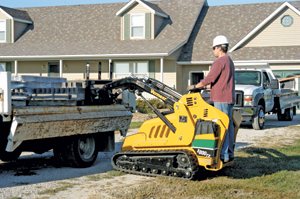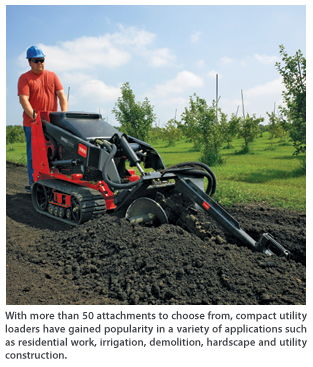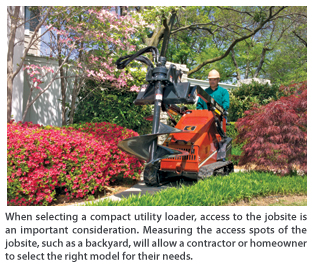Rental Relief

There’s no question that the past year has brought about a challenging time for contractors. The weakened housing market and recession made work scarce and equipment purchases halted as projects were few and far between. However, as conditions improve and the economy slowly recovers, crews need to be prepared to take on work. Cautious contractors looking to get back to the grind have brought about a strong trend in acquiring the equipment they need — rental.
 “With the downturn in the economy, people are fearful of spending money so they’re renting more,” says Andy Lewis, marketing communications manager for Compact Power. “As contractors saw less work over the past year, they hunkered down and didn’t buy new equipment because they were unsure if they could readily employ it. Now that work is starting up again, we have seen a surge in the rental business because these contractors still have to get the job done but are not quite comfortable in their workload to buy yet.”
“With the downturn in the economy, people are fearful of spending money so they’re renting more,” says Andy Lewis, marketing communications manager for Compact Power. “As contractors saw less work over the past year, they hunkered down and didn’t buy new equipment because they were unsure if they could readily employ it. Now that work is starting up again, we have seen a surge in the rental business because these contractors still have to get the job done but are not quite comfortable in their workload to buy yet.”
One piece of equipment that has become increasingly attractive in the rental business is the compact utility loader (CUL). Thanks to their versatility and compact size, compact utility loaders — also known as mini track loaders or mini skid steers — have become a mainstay in the equipment fleets of landscapers, contractors and homeowners looking for a small, but productive machine. With more than 50 attachments to choose from, there’s no wonder why this mini tool carrier has gained popularity in a variety of applications such as residential work, irrigation, demolition, hardscape and utility construction. However, with a purchase price of $13,000 to $25,000, hesitant equipment consumers are opting to rent CULs for use in their projects.
“This one machine can do a variety of tasks simply by changing out an attachment,” says Matt Collins, product manager for compact equipment at Ditch Witch. “From a contractor’s perspective, a CUL allows them to get more done on the jobsite, save time and ultimately affect their bottom line. Homeowners are able to do a wide range of tasks around their house and only rent one piece of equipment.”
Given the flexibility CULs have to offer an assortment of customers, many rental yards have increased the number of units they supply. Rental houses such as Sunbelt, Home Depot, True Value and smaller mom and pop operations have incorporated these small, but mighty machines from manufacturers including Ditch Witch, Bobcat, Boxer, Vermeer and Toro.
Depending on the size of the CUL, rental rates may range from $100 to $175 a day, $300 to $650 a week and $900 to $1,800 a month. For exact prices in a particular location, a customer should check with their local dealership or rental yard for pricing information, as it will vary from region to region and store to store, says Gerald Zastrow, product manager for Bobcat Co.
Attachments will also add to the price of renting a compact utility loader. Rental units typically come standard with a 36- or 42-in. bucket. Other popular attachments such as pallet forks, augers, trenchers and plows may require an additional cost. Non-hydraulic attachments can run a customer around $20 a day. Hydraulic attachments are a bit more pricey, with rental rates ranging from $50 to $80 a day, $150 to $180 a week and $450 to $700 a month.
“Oftentimes, rental stores have an additional charge for each attachment you rent. However, it still makes more sense to rent as many attachments as you need to accomplish your job,” says Greg Lawrence, product marketing manager for Toro. “Some people try to save a little bit of money by not renting the proper attachment and plan on just doing some of the job by hand. In the end, you will save more time and money by just renting the right attachment up front.”
Before a seasoned contractor or ambitious homeowner can snatch up this machine from a rental lot, learning which unit best suits their needs is important. While CULs are easy-to-use machines, manufacturers offer different features on their equipment that may be favorable for particular projects. A rental customer should evaluate his or her jobsite and desired application prior to selecting a loader.
Before You Borrow
Each jobsite and project calls for a piece of equipment uniquely suited for the task at hand. Prior to picking out a CUL to rent, a customer needs to consider the environment and duties he or she intends to use the machine in. This will ultimately allow the operator to be paired with a productive unit.

“The ground conditions will determine whether a contractor needs a tracked or wheeled loader,” explains Lawrence. “If they’re often working in sandy, soggy or muddy conditions, a contractor may want the added traction of a tracked unit to improve flotation in those environments. A tracked machine also may be the right choice for work on existing lawns, since tracks are better at dispersing weight across a surface, thereby creating a lighter footprint that won’t harm turf.”
Access to the jobsite is also important to consider. Measuring the access spots of the jobsite, such as a backyard, will allow a contractor or homeowner to select the right model for their needs. The overall width, length and height of a loader is an important aspect of the rental decision. Lawrence explains that in tight spaces, a wheeled loader can improve maneuverability due to its short wheelbase design, which also allows for easy negotiation of mounds, curbs and rough terrain.
As for a tracked option, Boxer offers a variable track feature on some of their units. This feature allows the tracks to withdraw under the machine, making the unit 36 in. wide when pulled in and 44 in. when pulled out. This allows the operator to easily maneuver through gates and other tight spaces.
“A machine with a variable track can easily become a narrower unit to drive through an entryway, past an A/C unit and along a retaining wall,” says Lewis. “If you’re going to use a big attachment like a backhoe or something that requires additional stability, it expands its tracks back out giving the machine a larger, wider footprint and increasing stability.”
Along the lines of the tracks vs. wheels debate, a rental customer needs to decide on whether he or she prefers a ride-on CUL or a walk-behind unit. While there are advantages to each style, a customer should choose which type best suits his or her comfort level during operation. For instance, Lewis notes that a ride-on unit can prevent an operator from trudging through a muddy jobsite — diminishing operator fatigue and increasing comfort. A walk-behind unit, however, offers increased safety since the operator’s feet are firmly on the ground while running the machine.
Overall productivity of the compact utility loader should also be considered. For example, a rental customer needs to take a look at the unit’s size and lift capacity. This will ensure that the machine is suited for the jobsite and applications it will be expected to perform in.
“Customers should familiarize themselves with the capabilities of each type of equipment they are interested in,” says Zastrow. “With mini track loaders, there are limitations. Their relatively small size limits the machine’s lift capacity so they are not the ideal solution for large capacity jobs, and certain attachments will be too large for the machines to handle.”
Checking for adequate horsepower and hydraulic flow is vital when deciding on a CUL. When searching for the right machine, make sure it’s capable of accomplishing the tasks you need and want it to do. Certain applications require more horsepower to get the job done quicker and more efficiently. Even attachments require certain hydraulic configurations and pressure for them to perform properly.
“A diesel engine will deliver more torque for increased pulling and digging force when using attachments in very aggressive or rocky conditions,” explains Lawrence. “In addition, a diesel model may be the best choice when working in high-altitude areas. Gasoline engines can run a richer air and fuel combination due to less oxygen in the air at high altitudes. The difference in air density provides lower combustion temperature and pressure, resulting in reduced horsepower.”
Finally, be sure to take the rental’s condition into consideration. Before getting ready to load the CUL onto your trailer, be thorough and inspect the machine. Ask plenty of questions and make sure it has been properly lubricated and serviced. Any downtime — especially on a rented machine where usage is limited — can cost you time and money.
“Do a general inspection of the machine and make sure there are no leaks — whether it’s antifreeze, oil, etc.,” says Jon Kuyers, utility product segment manager at Vermeer Corp. “Make sure oils are up to the recommended fill levels. Inspect the CUL for any damage such as if a track is cut up or the mounting plate pins are not working. Test out the unit and check if the functions are operable. Items such as filters, track tension or tire air pressure and grease should all be addressed prior to rental.”
Getting to Work

The vehicle should then be paired with a durable trailer — whether it’s the customer’s own or a rental. Some manufacturers offer trailers with their CULs that are made specifically for that piece of equipment. For example, Boxer has a system trailer that houses the machine and several attachments. Also, check that the trailer lights are in working condition before hitting the streets. Once the truck and trailer are ready, getting the machine loaded is the next step. It’s important to understand how to safely maneuver the unit and load it correctly to avoid any accidents, injuries or damage to the machine.
Collins offers 10 steps to properly loading and securing a CUL for transport:
- Always refer to the machine’s Operator’s Manual for proper loading techniques.
- Attach the trailer to the tow vehicle before loading and unloading equipment.
- Start the machine and run at low throttle.
- Raise the mount plate enough to clear the trailer, but keep it as low as possible.
- Move slowly forward onto the trailer until tie-down position is reached. Ten to 15 percent of total vehicle weight (equipment plus trailer) must be on the tongue to help prevent trailer sway.
- Lower the mount plate to trailer bed.
- Turn ignition switch off.
- Close fuel shutoff valve.
- Set parking brake (if equipped).
- Tie down unit and all attachments.
When tying down a unit, most manufacturers recommend using at least two chains — one on the front and one on the rear. Check with local state regulations for their individual laws and tie-down rules. All of the attachments should have their own chain and binder for transporting.
“Do not skip past the tie-down process and assume that the unit weighs enough that it won’t move around. One of these units can weigh 2,000 lbs and you may not think that’s going to go anywhere, but one good bump can shift it around,” says Lewis. “Don’t be afraid to ask a rental professional to double check tie-downs — safety in transportation is paramount.”
Until contractors feel confident in their workloads, rental is a viable and popular option for acquiring equipment. By doing their homework beforehand, a rental customer can find the right compact utility loader for their needs and get the job done.
Pam Stask is assistant editor of Compact Equipment, based in Peninsula, Ohio.
Borrowing BIG
Home Depot and Compact Power Team Up for Large Equipment Rental

Compact Power Equipment Centers is expanding into 115 Home Depot locations across the southeast with hopes of increasing its operational footprint to 250 stores by the end of 2010. Home Depot will continue to manage its Tool Rental Center, which offers products such as pressure washers, drills and other valuable tools to its consumers.
“As a company, we’re looking at rental customers in a two-fold fashion — contractors and homeowners,” says Andy Lewis, marketing communications manager for Compact Power. “Through this partnership, we’re enabling one-stop shopping for contractors and homeowners who are already at Home Depot picking up lumber and other supplies.”
In addition to its rental service, Compact Power will offer a mobile service where it will send out service technicians to fix any piece of rental equipment at a customer’s jobsite — saving them valuable time.





Comments are closed here.